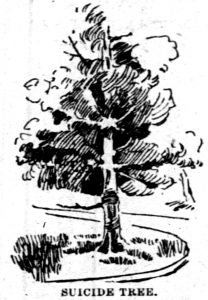
Image Courtesy The Cincinnati Enquirer, September 27, 1894 | Image extracted from microfilm by Greg Hand
Where in Cincinnati can you find a pathway named “Dead Men’s Row” and a “Suicide Tree”? You may not believe it when I tell you! As Halloween approaches, make a list of all the spooky, scary, haunted places in Cincinnati and the likelihood of Burnet Woods appearing on that list is very slight, indeed. And yet it was Burnet Woods, from the 1870s well into the 1900s, where Cincinnatians went to kill themselves.
Death records and old newspapers tell the grim tale: a 39-year-old man died from a self-inflicted gunshot to the head, a 50-year-old slashed his wrists, a man between the ages of 45 and 50 died by hanging, a 25-year-old shot himself, a 60-year-old hung himself, a 47-year-old took a pistol to his brain, a 54-year-old drank poison, a man of 63 years took a gun to himself, a 22-year-old shot himself, a 35-year-old hung himself from a tree, another 58 year-old died from a gunshot, and a 27-year-old shot himself in the chest. All of this occurred in Burnet Woods. And all were men.
Cincinnati Police Sergeant Martin F. Rifenberick told The Cincinnati Enquirer [September 27, 1894]:
There has never been but one woman who committed suicide out here to my knowledge, and she did it by jumping into that lake over there.
Sergeant Rifenbeck, with years of experience patrolling the park, expressed his opinion that women preferred water as a means to end their lives, and noted the number of women found drowned in Cincinnati’s canals.
On the western side of the park, a lofty oak earned the title “Suicide Tree” because of all the bodies found hanging from a conveniently placed limb. According to The Enquirer, the tree was infamous:
Who has not heard of ‘The Suicide Tree’ in Burnet Woods, so frequent has been the report of death from this noble knight of the North Vine street forest? That one particular tree should be selected under whose foliage a last farewell of life and its cares is to be taken seems odd, and so do many other things in connection with this ever increasing mania for self-destruction.
In one case, an elderly former policeman shot himself under the Suicide Tree and, shortly thereafter, the body of his roommate at the Old Men’s Home was found under the same tree, also dead from a gunshot.
Although the Suicide Tree got the reputation, bodies of suicides had been found throughout the park. Fridolin Schumann, renowned proprietor of one of Cincinnati’s classic German music halls, for instance, ended his life by gunshot while leaning against a beech tree in another part of Burnet Woods. Park Policeman Gus Wagner told The Enquirer:
You have only to go back far enough to find that almost every tree in Burnet Woods is a ‘suicide tree.’ I can point you out any number that have sheltered the bodies of suicides over this grove since my time.
In the southeastern section of Burnet Woods, a pathway winding through a delightful grove of trees had gained the name “Dead Men’s Row.” According to The Enquirer:
It is a pleasant drive, rich with foliage and carpeted with velvety grass. There is nothing about its appearance to suggest such a grewsome name, since it is nearly always mottled with shade and shine. A number of unidentified bodies have been found from time to time strewn along it, until it was christened as indicated.
The Enquirer reporter who wrote this 1894 investigation was struck by the irony of a beautiful location attracting such tragic events. Why, he asked, was Burnet Woods burdened with so many sorrowful acts?
Just why persons, who contemplate taking a voyage across eternity at their own instance, should select one of the most beautiful portions of the city from which to embark, is not exactly as plain as it might be. It would seem that those who have resolved to commit suicide would rather choose some spot whose miserable surroundings were more in conformity with their own hearts and feelings.

Image Courtesy The Cincinnati Enquirer, September 27, 1894 | Image extracted from microfilm by Greg Hand
By 1908, the Burnet Woods Suicide Tree had been cut down, yet it remained legendary. This proved useful to Jerry Conners and Pete Hoffner, two watchmen assigned to the day shift at the park. Picnickers, particularly women and children, proved to be an ongoing irritation. They brought their lunches and stayed all day, but rarely cleaned up after themselves. This left the collection and disposal of discarded food, torn boxes, and paper wrappings to the watchmen.
While making a mess, the women often asked the watchmen to point out the Suicide Tree. According to The Cincinnati Post [October 9, 1908], this inquiry allowed the watchmen opportunities for revenge:
When a woman asked where the Suicide Tree was situated they usually answered, ‘You’re sitting right under it, madam.’
A stampede followed.





Facebook Comments